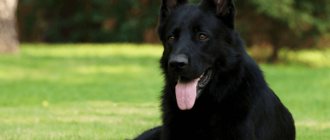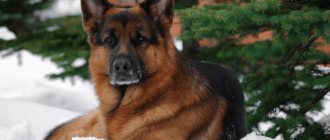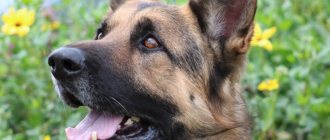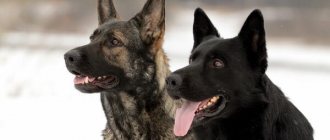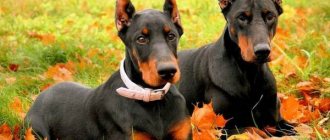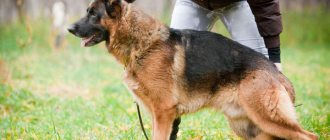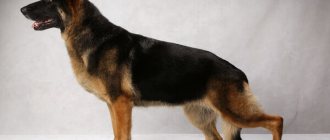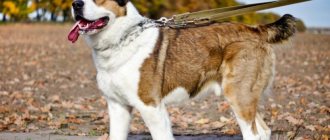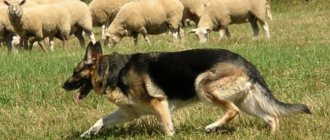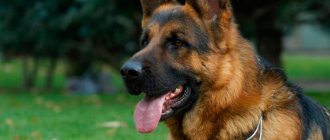Do you know the difference between a long-haired German Shepherd and a short-haired one? No? Then read this article. The coat protects the German Shepherd from various natural conditions, such as sun, rain, snow. The length of the fur in different parts of the body is different from the covering on the head, where it is short. And also on the ears and the front base of the limbs.
In other parts of the body, the dog is “equipped” in a variety of ways. What is the main point? The German's coat has two layers: undercoat and guard hair. The first, tightly fitting to the body, serves as protection from bad weather. The second one warms.
Although only one type in the standard is normal, there are three types of cover:
- short-haired breed;
- Wire-haired long-haired;
- long-haired German Shepherd.
Breed characteristics
| Short description | |
| Origin: | Germany |
| Conditions of detention: | Private territory, apartment building |
| Purpose: | All types of canine services, companion |
| Color: | Black |
| Wool length: | Smooth-haired – 4 – 6 centimeters; Longhair – 8 – 10 centimeters |
| Adult dog size: | Height 53 – 66 cm; weight 32 – 39 kg |
| Average life expectancy: | Up to 16 years old |
| Walk: | Every day, at least 2 times a day |
| Physical activity needs: | Very high |
| Fédération Cynologique Internationale (FIC) classification: | Group 1: Herding and guard dogs. Section 1: Shepherds |
| Puppy price: | Varies from 15 to 75 thousand rubles |
How to feed?
Experienced breeders recommend feeding German Shepherds with ready-made super-premium food, or creating a natural menu so that the pet gets enough of all the nutrients, while more than 80% of the diet comes from animal proteins.
What exactly to feed your dog is up to you, but in terms of how to do it, it’s better to follow the standard rules:
- An adult needs 2 feedings a day. The portion can be adjusted depending on the size and physical activity of the dog. If you have chosen a natural diet for your pet, and the dog itself lives on the street, serve the food only warm. Be sure to wash all dishes after each meal.
- Make sure your dog always has access to clean water. The daily fluid intake is calculated using the formula 50 ml per 1 kg of weight for an adult dog, or 100 ml per 1 kg for a puppy.
- Don't feed your dog from the table. No matter how your pet begs, do not give him flour, sausages and confectionery products. They have an extremely negative effect on the animal’s body.
History of the origin of the species
Purposeful selection of German shepherds began in 1884, although four-legged shepherds similar to modern “Germans” appeared in northern Germany much earlier. The “father” of the breed was Max Von Stefanitz; he was the first breeder, thanks to whom the whole world saw an intelligent, beautiful and courageous animal.
Black puppies in the litter were discarded for a long time; only black and white dogs were bred. Only in 1906 did the first completely black specimen appear at the exhibition.
During the Second World War, the breed was actively used in the canine units of the German troops, thanks to which black shepherd dogs appeared in the vast expanses of the Soviet state. But massive military operations almost led to the complete destruction of the breed. In the post-war period, the livestock had to be restored bit by bit.
In recent years, the German Shepherd has become one of the most popular breeds due to its versatility. There are still few representatives of the black color - no more than 4% of the total livestock.
Purpose
It is impossible now to find a profession that this dog has not yet mastered. Can be a security guard, bodyguard, policeman, soldier, assistant, companion, even a nanny for children, a guide. Initially, the breed was bred for guard herding purposes. The fact is that the basis for the creation of the breed was the principle: “a German shepherd is considered to be any herding dog living in Germany, which, with constant training, will achieve physical and mental perfection as part of its utilitarian function.” This is exactly what happened to the breed.
Distinctive features
Pedigree description of black shepherd dogs:
- General form. A fairly large dog of an elongated format with a strong body structure. Calm and balanced behavior. A distinctive feature is a creeping gait.
- Height and weight. The height of male dogs should not exceed 65 cm at the withers, weight no more than 40 kg. For females – 63 cm and 32 kg, respectively.
- Head. Proportional to the body, wedge-shaped. The width of the skull is ideally equal to the length. The eyes are dark brown, almond-shaped, and may sometimes appear slightly slanted. The ears are large, erect, and have dense cartilage.
- Muzzle. Strong, powerful jaws. Bite – scissors, 42 teeth. The jowls are dark in color, fit tightly to the jaw, but not dry. The length of the muzzle is equal to the length of the jaw. The nose pigment is only black. A small hump is acceptable.
- Neck. Strong, muscular, medium length, dewlap undesirable. Smoothly transitions into the line of the withers, the angle relative to the body is about 45 degrees.
- Frame. Sturdy, muscular, strong, without dampness. The back is moderately long, the loin is wide. The croup is long, slightly sloping (about 23 degrees relative to the horizon). The chest is moderately wide and deep (chest depth 45 - 47% of the height at the withers). Fortbreast is well expressed. The ribs are oval.
- Limbs. The shoulder blades and shoulders are the same length, the angle of articulation is no more than 110 degrees. The front legs are straight and parallel to each other when viewed from the front. The toes are tightly gathered into a ball; dewclaws are absent. The thighs and lower legs are visually the same length, the thigh is strong and muscular. The hock joints are strong, the metatarsus is vertical to the hock joint.
- Tail. The tail is saber-shaped, set low, never rising above the level of the back. The length of the tail should be below the hock but above the middle of the metatarsus.
- Wool and color. Black German Shepherds come in 2 variations: long-haired and short-haired. In both subspecies, any inclusions or markings of other colors are undesirable. The guard hair is of medium hardness, with a dense dense undercoat.
Description of pets
This breed can vary greatly in appearance, and short coat length is also standard.
The short-haired (smooth-haired) Shepherd is distinguished by a thick and hard coat with a dense undercoat . The hairs lie tightly to the body. It is acceptable for the hair to be slightly longer on the tail and back of the thighs.
Character
Obedience, intelligence, humility and selflessness are the key character traits of dogs of this breed. The way they understand a person and feel the situation is pleasantly amazing .
The dog patiently endures strong hugs and tail pulling from small children and does not pay any attention to the dirty tricks of cats.
The dog has a keen sense of people and sometimes begins to suspect faster than the owner that his opponent is up to something wrong . The Germans are not characterized by causeless manifestations of aggression
The shepherd is ready to protect its owner even at the cost of its own life. She becomes attached to all members of the household and is very sad during times of separation.
Photo of an adult dog
Interesting Facts
Curious information about the breed:
- In the 19th century, shepherd dogs were often called "red stockings" because of the fawn markings on their legs that resemble stockings.
- Beaucerons have an innate habit of biting people or animals on the legs. This is how they used to manage their flocks of sheep. Now this is not a manifestation of aggression, but the dog’s sincere care and desire to “guide a person on the right path.”
- According to official data, about 7 thousand Beaucerons are registered in the world - this is a very rare breed of dog.
- During World War II, shepherds worked as sappers, mail carriers, and scouts.
German Shepherd black long-haired – photo
Long, thick fur the color of a raven's wing will not leave anyone indifferent. Long-haired Germans look larger and more impressive than their smooth-haired counterparts.
Character of dogs of this breed
The German Shepherd has a calm, reserved temperament. Her character is flexible, friendly, and non-conflicting. Aggression is shown only in extreme cases. Most photos on the Internet show how these pets love their owners and care for children. They will tolerate many pranks; the pet will never show aggression towards a child. They are tolerant of other animals, especially if they grow up together.
High guard qualities and developed intelligence allow the dog to assess the threat to the life and property of the owner and even make independent decisions. He has a well-developed protective instinct; she can even sacrifice herself to save any family member. There is no cowardice or cowardice among the Germans. They are brave, loyal, hardworking.
This dog cannot be punished or humiliated. This will cause psychological trauma to the pet and may cause mistrust in the owner. For an offense you need to scold, the Germans are able to realize their guilt. Dogs of this breed do not like to be alone. For a normal psychological state, they need communication with a person. Therefore, this breed is not suitable for those who work all day or are often away. The Germans have a connection with their beloved owner on a psychological level; they feel the person’s mood.
How to train
The German Shepherd does not immediately become smart and obedient. She definitely needs to be raised properly. These dogs are easy to train and quickly understand basic commands. But training of German Shepherd babies begins from the first days of their appearance in the house - from about 2 months of age. Without training, an uncontrollable, aggressive dog can grow up, causing problems for its owners and everyone around them. It will be difficult to retrain an adult German Shepherd later.
Sit command
Working with German Shepherd puppies is necessary in a playful way so that the kids find it interesting. These pets are pliable, intelligent and obedient, so training will not bring any problems. The main thing is to be consistent and patient. It is mandatory to teach the commands “Come to me”, “Sit”, “Lie down”, “Place”, “Fu”, “No”, “Near”, “Walk”. On the street it is necessary to accustom him to a leash and muzzle. To encourage during the training process, you need to use affection, praise or treats. It is very important to gain authority from the very beginning with your pet.
Even if the pet will not be shown, it is advisable to take a handling course with a professional trainer. He will teach the shepherd the correct stance with one hind leg extended back. It is also worth contacting the services of training professionals if the pet will guard the house or babysit children, as well as if behavioral problems arise.
You can watch a video about mistakes in training shepherds.
Video: German Shepherd. Training mistakes
Photos of puppies
Color
It can be any solid color, except chestnut and white. The most common colors are black, gray and fawn. Interestingly, a French Shepherd can change color throughout its life. Black fur is often mixed with light hairs. The standard does not allow only the appearance of white spots. With age, such animals can acquire a gray “fur coat”.
Features of character and behavior
The Black German Shepherd is a unique gem among other breeds . A simultaneous combination of courage, strength, endurance, efficiency, a high level of discipline and security qualities. At the same time, she remains a reliable, devoted friend for the owner, a reliable and attentive nanny for the child.
The shepherd learns quickly and with pleasure, remembers commands for a long time - in the ranking of the smartest dogs it takes a well-deserved 3rd place.
Tolerant of all “pack members,” even if they are cats. With good socialization, he has a neutral attitude towards strangers, tolerates all manipulations with himself (even not very pleasant ones). Remains a vigilant watchman and reliable guard of the boundaries of the master's possessions.
The breed's temperament allows black German Shepherds to be used in any type of canine sport, military and police service, as a guard of private territory or simply as a companion dog - one of the most versatile breeds.
Unfortunately, the popularity of the breed has led to massive and unsystematic breeding by unscrupulous breeders . Which, in the pursuit of profit, undermined the mental health of shepherd dogs, such a fate befalls all popular breeds. Therefore, you need to be careful when buying a puppy - buy a black German shepherd only from trusted kennels.
Advantages
One can talk almost endlessly about the advantages of “black Germans,” but here are the main ones:
- mind;
- high level of obedience;
- motivation in classes;
- fast learner;
- versatility of use;
- aesthetic beauty;
- force;
- courage;
- endurance;
- unpretentiousness in content;
- vigilance towards strangers;
- Suitable for beginner dog owners.
It is almost impossible to find another dog that combines so many positive qualities.
Flaws
Despite the many advantages, there is also a downside to the coin:
- Hyperactivity.
- Poor health.
- Excessive barking.
- Heavy shedding.
All of the above can be avoided with decent maintenance and proper feeding.
Advantages and disadvantages
- German Shepherds are very intelligent and capable when trained. They are excellent guards and keep the whole situation under control. They love and care for children very much, sometimes even excessively, they are suitable for family care, devoted, obedient.
- If you don’t have an approach to them, learning will be difficult.
- The problem is the shedding of the animal.
- If the dog is not busy, it can find work for itself, sometimes not useful, even harmful for the owners.
Dear readers, tell us about your pet. How are you friends with him, what interesting incidents happened to him? How did the article benefit you?
Care and maintenance
Black representatives of shepherd dogs are unpretentious in keeping, they get along well even in city apartments, subject to long walking and regular training. Keeping it in private homes is permissible even in an enclosure; the breed is hardy enough to easily survive the winter if provided with a warm booth . But from the point of view of animal psychology, “Germans” are much better off living next to their owners; this dog was born to work in tandem with a person. A long separation from their flock is hard for shepherds to endure.
If a Black German Shepherd is not given regular exercise, it will begin to look for entertainment on its own - as a rule, this has devastating consequences.
Nutrition
Black German Shepherds have a relatively “weak” stomach, which is why more and more professional breeders are choosing commercial dry food. Modern ready-made super-premium food or holistic food for large breeds meets all the requirements of a balanced diet. Economy and premium food are not suitable for German shepherds, although their price is much more reasonable. But a large number of cereals in the composition are not nutritious enough, and much more cheap food is required per feeding, compared to “holistic” food.
Natural feeding is very difficult to balance correctly on your own. The diet must include:
- Muscle meat and offal – 2/3 of the total diet.
- Low-fat cottage cheese and kefir.
- Vegetables and unsweetened fruits.
- Cartilage and tendons.
We recommend that you read the article on the topic: “Porridge for dogs: recipes, do’s and don’ts, review of the composition and value of cereals.”
A categorical taboo for all shepherd dogs:
- sweets and chocolate;
- bones;
- spoiled food;
- salt, spices.
Sources of carbohydrates (porridge) in a dog’s diet are acceptable, no more than 10% of the total feeding portion.
200 grams of chocolate can lead to severe poisoning or even death of a black German shepherd.
Health
Conscientious breeders carefully reject sick animals from breeding, buying a puppy from a good nursery; the chances of buying a sick animal are minimal. When raised properly, the Black German Shepherd is a strong and healthy dog.
Rational feeding, regular exercise and timely examinations by a veterinarian are the key to your pet’s health.
Vaccinations
Immunizations are carried out to ensure the safety of infection with infectious diseases. The first vaccination is given at the age of 7-8 weeks, with preliminary double deworming. After 21 days, revaccination is carried out with the same drug to consolidate the result.
Along with a double vaccination against infectious diseases, an injection against rabies is often given. Sometimes the veterinarian postpones vaccination against rabies until the teeth have completely changed; this depends on the conditions under which the pet is kept and the epidemiological situation in the region of residence. After all vaccinations, quarantine is observed for at least another 10 days.
After immunization, animals may experience weakness, lethargy, and refusal to eat. Allergic manifestations to modern serums are not observed.
Important article on the topic: “Everything you need to know about dog vaccinations.”
Diseases
Despite the strength and endurance of black German Shepherds, the excessive popularity of the breed has led to a number of breed diseases:
- Volvulus.
- Dysplasia of the hip or elbow joint.
- Weakened ligaments and tendons.
- Metacarpal measurements.
- Cryptorchidism.
- Intervertebral disc prolapse.
- Dysfunctions of the digestive system.
- Inflammatory diseases of the cornea of the eyes.
Breeders are trying to fight breed diseases, but while there is a demand for puppies without pedigree documents, health problems remain.
Walk
Shepherds are an active breed that requires appropriate walking. Without proper physical activity, manifestations of destructive behavior are common - excessive barking, digging, chewing on things in the house. An adult “black German” needs to be walked at least 2 times a day, 1.5 – 2 hours for each walk. Puppies should go outside 4 times a day , as young animals need to relieve themselves more often.
Walks must be accompanied by active games and training. This is necessary both for the proper development of muscle mass, skeleton, and the mental health of the dog.
Grooming
Short-haired representatives of the breed are not fussy about grooming. It is enough to wash the dog once a month and comb it 1-2 times a week with a slicker brush and then with a furminator. During muddy weather, to keep the house clean, it is recommended to wash your dog's paw pads and belly with a mild shampoo or special paw soap.
You cannot use human shampoo, as this will lead to dry skin and fur and the appearance of dandruff.
For long-haired representatives of the breed, grooming is much more difficult. The frequency of washing does not change, but you need to comb your pet much more often. To care for long guard hair, you definitely need a comb with sparse teeth, which will have to be combed daily to prevent tangles from forming. Also, after standard bath procedures, it is strongly recommended to use a special balm.
Using conditioner helps prevent tangles and makes long, thick mane easier to comb.
Life expectancy, illness and health
The German Shepherd is a hardy and strong breed whose representatives live from 9 to 15 years .
They easily adapt to any climate and feel comfortable both in an apartment and in an insulated booth outside. However, this does not mean that the owner can neglect a routine examination by a veterinarian.
Representatives of this breed often suffer from the following types of diseases :
- volvulus;
- food allergies;
- diabetes;
- dysplasia of the elbow or hip joint;
- hind leg failure;
- intervertebral disc diseases;
- chromate;
- growth hormone deficiency;
- aortic stenosis;
- exudative pericarditis.
The weakest point of a shepherd is the organs of vision . Germans often suffer from infectious eye diseases, myopia and blindness.
If you keep your dog outside in an enclosure, check its eye health regularly.
Mating - how to get black puppies
In German Shepherds, a recessive gene is responsible for the black color, so you can only get a 100% litter of black puppies from black homozygous parents. Which is impossible in everyday conditions, since without laboratory tests it is impossible to find out whether the parents are homozygous or heterozygous.
Even completely black representatives of the breed usually give birth to zonal or black-backed puppies, since these colors are dominant over black in the breed. Gametes from black heterozygotes produce saddle and zonular colors with a higher probability than black. Simply put, black parents may have only 1 or 2 raven-colored puppies in their litter.
Professional breeders, aimed at breeding all-black shepherd dogs, arrive at the desired litters only after 4 – 5 generations of crossbreeding. Often resorting to inbreeding, breeding black German shepherds is not recommended for beginners.
Read a detailed article on the topic: “Everything you need to know about breeding dogs: appropriate age, what to do if it doesn’t work out, rules and tips.”
Basic colors
The standard includes the following three types of color:
- Black and black is the most common color. Occurs in more than 90% of individuals. Distinctive color features: a triangular black spot, from the elbows to the tail, and a light color covering the belly, paws and neck. There is a black mask on the face and ears. Its absence is a sign of marriage.
- Zonal (wolf, gray, gray) - this effect is obtained due to the special color of the hairs. At the very root they are light, then a little darker, higher towards the tip they are yellow, and the tip itself is painted black. The most intense and darkest color is on the face, back and tail. The zone color accounts for only 5% of the 100 representatives of the breed.
- Black – the dog’s entire body is covered in a luxurious black fur coat. Insertion of any other color is a defect. According to statistics, black German Shepherds make up only 3% of the total number.
Black puppies become lighter as they grow, while pure black puppies remain that way throughout their lives..
Key points in training
“Germans” are incredibly smart and always want to please their owner; the training process does not bring much trouble. German Shepherds enjoy exercising, especially if the training is done through positive reinforcement.
Training is necessary, otherwise the pet’s irrepressible energy will go in the wrong direction. The main obstacle to training can be the dog's hyperactivity, which interferes with concentration. Team training should begin after a walk, so that natural needs do not distract the pet from training.
Read about how to properly train a dog in the article: “Training a puppy: effective methods from dog handlers, learning commands at home.”
How does it relate to children and pets?
German Shepherds are cold and reserved towards strangers, however, they have great affection and love for their family members.
They treat children like nannies: they support the game if the child asks for it, or silently watch the little one from the side so that he does not harm himself.
If the baby begins to pull the dog’s tail or ears, the most the shepherd can do is hide or go to another room.
In relation to other animals, the shepherd behaves quite neutrally, however, males, especially young ones, will try to dominate and take the role of leader of the pack.
Where can you buy and how to choose a black German Shepherd puppy
By purchasing a dog from a trusted kennel, the risks of buying a sick animal or a mixed breed are minimized. When choosing your best friend for the next 10 - 12 years, do not hesitate to ask questions to the breeder; a good breeder will be happy to explain all the dilemmas of a novice dog breeder.
You should be wary of breeders who rehome puppies at 3 to 4 weeks of age. The baby must go through the first stage of socialization with its mother and littermates. Favorable age for moving is from 2 to 4 months.
Before buying a puppy, you need to pay attention to its behavior. Cowardly, frightened animals are immediately rejected. A good puppy should be active, enjoy playing with his brothers and sisters, and be curious about people and toys. You can ask the breeder to demonstrate the puppy's parents to observe their behavior and character.
Nurseries
Since the breed is quite rare, there are few specialized kennels for black German shepherds:
- "Gladiator";
- "Best of the Black"
You can also find puppies of rare colors in kennels of ordinary shepherd dogs:
- "Haus Schiran";
- "Samara Land".
The black German shepherd is an excellent friend and companion for people leading an active lifestyle or professional athletes. The high price of a puppy is only a small price to pay for the boundless love and devotion that the pet will give throughout its life.
5 / 5 ( 2 voices)
Breeding lines
Although they are all considered the same breed, each has its own "line". These lines usually indicate the dog's heritage, and the differences between the types of German Shepherds usually stem from the purpose for which the dogs were bred. Although there are technically seven different types, there are only two main lines: show and work.
Show lines from America, Canada and West Germany were bred with an emphasis on the appearance of the dog, based on body type, color and coloration, and not on health and personality, while in working lines, on the contrary, the main emphasis is on the health and quality of the dog, than on external characteristics. Below are the most recognizable types of German Shepherds, their distinguishing features and characteristics.
Old type
Initially, these dogs had a dry, wiry body and a narrow chest. When creating the breed, people needed a powerful, but at the same time agile and fast animal. But there was not as much attention to external criteria as there is now. The old type, in terms of leg length and square proportions, is more similar to modern Malinois (Belgian Shepherds). This line is considered by breeders to be an important historical element in the creation of successful advanced modern dogs, but there is no point in going back to the roots.
Working
Max von Stephanitz is the man who developed the German Shepherd and set the standards for the breed. West German Working Lines are the dogs that most closely resemble his vision. There are actually five species of this dog, but they are all grouped together. Each variant has its own color and coat type. The most common color is black saddle, but they also come in zoned, sable, two-tone and sometimes pure black.
Working lines of the West German Shepherd have more sloping backs than the East German Shepherd. Plus, they are not as dark as their Eastern European cousins.
These dogs have an even temperament and excellent working qualities. They are good at security, protection, rescue operations to find people. However, due to their calm temperament, they also make good pets if trained.
This dog's only problem may be health problems. In West Germany, health requirements are not as strict as in East Germany, so breed defects may occur. One of the most common health problems is the aforementioned hip dysplasia.
West German exhibition
These dogs are stockier than the American lines. Their heads are larger and their fur is more luxurious. They can be of different colors. The two most common are black and light brown, and black and tan. The rules for breeding West German show lines are very strict. What is controlled by a specialized club that enters dogs into the breed register.
Every dog on this list should win competitions and dog shows. They must also undergo a health check. German Shepherds are prone to hip dysplasia, and if an individual has this disease, further breeding is not allowed. Like the American lines, they also make good pets. They are easy to train, perhaps even more so than their American counterparts. But they also have their own character flaws, such as emotionality and imbalance in stressful situations.
East Germany
This lineage dates back to the 1940s and 1950s, when East Germany was separated from West Germany. Which helped in maintaining the East German work line. They were raised as guard dogs or to work in the police and army. They are smart, loyal and have no temperament problems. Compared to their West German cousins, they are less prone to health problems, and few suffer from hip dysplasia, which is common in the West German line.
East Germany has even stricter breeding standards, so if a dog has health problems such as hip or elbow dysplasia, it will not be allowed to breed further. This is done to ensure the “purity” of the line. Each puppy is also tested before sale to ensure there are no health problems.
These dogs have strong bones, large heads and broad shoulders. However, despite this, they are smaller than West German individuals. East German Shepherds are typically dark in color—black or sable with brown spots—and have more wolf-like features. They also have longer hind legs and a more stereotypical "dog" gait instead of the flying trot so typical of show dogs.
These dogs were specially bred to guard property, protect people, and are accustomed to long working days. However, this does not mean that they will not make good pets. They just need to devote enough time to physical and mental training.
American
German Shepherds were brought to the United States in the late 1800s, but rather than being used as working dogs, they were bred as a show breed. Over the years, they began to differ from the working German Shepherd, for example, the angles of the hind legs became much wider. This indicates that the dog's body is inclined downward from the head to the hind legs. They are also taller and longer than the original German Shepherds.
American show lines come in white, black and tan, sable and two-tone.
They tend to be lighter in color than the European ones. Their coat is also thicker and longer than that of working dogs. American lines are not only show dogs, but also wonderful pets. They are calm dogs with less energy than working dogs, but still require plenty of exercise and tasks. All German Shepherds love to be helpful. American lines are also not difficult to train.
In addition, American lines of German Shepherds can be used for herding sheep and other animals, but their main purpose is to participate in competitions and exhibitions. They are superbly built and incredibly agile when overcoming obstacles. Not many of these dogs are used as police or guard dogs as they do not have the necessary qualities and dexterity. However, there are exceptions to the rule, and some individuals may actually work in law enforcement.
Chinese
In the People's Republic of China, in the second half of the last century, three types of dogs were bred:
- Chinese Shepherds;
- kunming;
- Chinese red mountain.
When they were created, they crossed wolfhounds, local dogs and, of course, German shepherds. The Chinese line looks more interesting than the others, has the most similarities with the German prototype and is distinguished by long limbs and square proportions. The dogs have a calm disposition, are easy to train and are used as quality service breeds.
Czech (Slovak)
The Czech Shepherd is a large dog, very similar in appearance to the Eastern Working Line. But more friendly and less aggressive. The Czech (Slovak) is taller and more muscular than its original prototype. In addition, they do not require special care and do not have serious health problems. However, very few dogs of this breed are available worldwide, as modern breeding only began in 1984.
Czech Wolfdog
The Czech Wolfdog was originally bred as a border dog in communist Czechoslovakia after World War II. They have a huge reserve of energy and strength. Czech work lines are strong and very agile. They are similar to the German Shepherd, but smaller in size than any of the other species listed above.
Their coats are also much darker, and unlike show dogs with two-tone coats, these guys tend to be one color, gray, dark brown or black. They are more like wolves than dogs.
This species also has fewer health problems than any other line, which also applies to their behavior. However, they will not make good pets unless you give them enough time and effort and proper training from childhood. These are dogs that are mostly bred for service and they excel at protection and guarding.
Most Czech working lines can be traced back to one nursery, which is quite surprising.
Belarusian
Very intelligent representatives of their species, they were used as service and guard dogs. They are bred to work at low temperatures. The first were bred in 1930 by crossing the German Shepherd and native Russian breeds, one of which was the Laika.
British
This line of dogs is distinguished by heavy and massive bones, a long body, beautiful shoulders and a gentle character, but a fickle temperament. In England they are actively used as police dogs and guide dogs.
American shiloh
The American Shiloh is considered a rare dog and is not recognized by any major kennel club. This breed is still in development and needs to be recognized. Shiloh Shepherds are very similar to German Shepherds, but they have a mix of Alaskan Malamute in their blood.
Thus, they turned out to be larger in size and much fluffier than the standard. They are also distinguished by their kind and flexible character. But they are not at all suitable for security and police service. The Shiloh was admitted to its first official breed club (International Shiloh Shepherd Registry Inc) in 1991. The American Shiloh is an intelligent and energetic dog that requires plenty of exercise and space to run and play.
If they don't get enough of it, they become aggressive. But with proper education and sufficient physical strength. Under load, these dogs become good companions, and can even be kept in an apartment without any problems.
Dutch Sarlouz Wulfhound
The Dutch Sarlouz Wulfhound was created by crossing a purebred German Shepherd (East German lines) and a wild European wolf. This line of dogs combines the external parameters of both representatives. But it differs from a typical eyebright in its fragile build and grayish color (white or dark brown is also possible).
Sarlouz is a mentally stable and balanced breed, but is characterized by excessive independence and aggression. Not suitable as service dogs.
Polish Podgalian Shepherd Dog
A beautiful, friendly and sociable dog, bred in Poland. It is characterized by average dimensions: height – from 62 to 68 cm, weight – from 45 to 48 kg. Has beautiful bright fur. This dog belongs to the group of mountain, cattle breeding and guard dogs.
In Poland, it can be found in police and rescue groups. He has good physical characteristics and is characterized by responsibility and caution. At home it can hunt rodents. The Polish Podgalian Shepherd Dog is calm, but can easily lose its temper if it encounters an ill-wisher. Effective in terms of security.
Australian Shepherd
Of all types of shepherd dogs , this one is the most talented shepherd and cattle breeder. It differs from others not only in its unique set of performance characteristics, but also in its pretty and bright appearance. Despite the name of the breed, it was bred in the USA.
The dog's weight is from 22 to 29 kg, height is from 44 to 53 cm. Males are much larger than females. The dog's body is covered with very soft long hair. It must be combed every season to speed up the recovery process.
Initially, the breed was bred to help American farmers who raised large numbers of livestock. Its representatives responsibly watched every sheep, pig or cow that grazed. They did not give predators the opportunity to approach the herd. And these talented shepherd dogs could find lost cattle and return them to the herd.
Today, such a pet is often purchased for companionship rather than for farm service. The Aussie is cheerful, calm, playful and very loyal. Loves to walk outdoors in company. Gets along well with any animals in the owner's house and does not conflict with them.
Belgian Shepherd
An excellent tracker and shepherd. Height – 56-54 cm, weight – 20-26 kg. Types of Belgian Shepherd :
- Malinois - red, short-haired.
- Laekenois - red and tan.
- The Tervuren is red-fawn and may have dark markings on its body.
- Groenendael - wire-haired, pure black.
Each of these types of dogs has a harmonious physique and proud posture. These animals are beautiful and responsible, they inspire trust and respect. Thanks to his excellent working qualities, the “Belgian” is exploited by the police. The dog is able to find a person under the rubble, follow the trail of an escaped prisoner, neutralize an armed robber, and even help an old woman cross the road.
These dogs are also used for herding livestock in villages or farms. The animal observantly looks after its “charges”, preventing any of them from getting lost. It gets along well with children, old people, in a word, with anyone. Willing to make contact and easy to train.
A dog of this breed sincerely becomes attached to its owner. It loves and respects him, so it prefers to spend most of the day alone with him. But he won’t refuse another member of the household a game, especially a fun and active one.
Nutrition
Briard is a large dog. Accordingly, she eats a lot. Great attention must be paid to the proper diet of the animal. You can feed your French Shepherd both dry food and natural products. The advantage of this breed is the absence of digestive problems. However, there is one nuance that owners need to know. In summer, it is necessary to significantly reduce the number of calories by adding more vegetables to the diet, since in the heat the animal’s physical activity decreases significantly. In addition, it is advisable to reduce the amount of protein consumed and add vitamin E, peanut butter or yeast.
How to distinguish a breed from a crossbreed or mongrel
The surest way to purchase a purebred German Shepherd is to do so from a reliable kennel. Then the puppy will have a pedigree, a metric (puppy card), a brand with a unique number in the groin or on the ear. And you won’t have to guess whether you bought a purebred dog or not. When buying from private breeders or on the market, there is always a risk of making a mistake, because an amateur is unlikely to be able to correctly evaluate the breed. In this case, decide on the purpose: why you need a dog. To participate in exhibitions and breeding work, you need to look for a puppy only in nurseries with a good reputation. For official or security work - in the same place, because the character of a real German Shepherd, which made it a legend and a movie star, is also a sign of the breed. But then appearance is not so important, and the dog will cost much less.
The new owner signs the puppy inspection report (below) and the certificate is certified with a seal
If you want to have a companion dog with the appearance of a German Shepherd, then you can take the risk of purchasing it on the market or through “buy and sell” advertisements, but at the same time remember that a grown-up pet may unpleasantly surprise you with its difference from true “Germans”. There are signs by which you can try to distinguish a purebred puppy from a mestizo or mongrel:
- “Germans” have almond-shaped eyes with snow-white whites, while mongrel dogs have round, sometimes convex, eyes with yellowish whites or dark spots;
- an ordinary puppy cannot boast of a perfectly smooth topline and a body elongated like a torpedo;
- the tail of a small shepherd never rises above the line of the back and does not curl into a ring, like that of mongrels;
- The ears of a “German” should be floppy and soft for at least 4–5 months, while a mongrel’s ears may stand up at any time or not at all;
- A purebred baby does not have a stripe between the eyebrows (frontal furrow) on the forehead, but a purebred baby may have one;
- A shepherd puppy grows and develops much faster than a yard puppy, so at the same age he will weigh more and look more mature.
A “German” puppy is more inclined to communicate with a person than a mongrel puppy
Video: how to choose the right German Shepherd
Basque Shepherd
The breed was developed in Spain to help farmers. The Basque Shepherd is an excellent herder, one of the best four-legged shepherds. It grows up to 58-60 cm, gaining weight up to 35 kg. Shepherd's appearance : rectangular build, expressive eyes, long, slightly curly hair.
She radiates positive energy, which is why she has won many fans. Such a pet is responsible, smart and loyal. He strives to please his beloved owners, so he rarely indulges. Don't mind playing, running or barking. Loves the company of people and animals. Contact and social.
The dog is used in police service. It is often used for rescue purposes. The animal loves people so much that it is ready to help them in any situation. It also has security potential, so it can be used for guard duty.
Kelpie
Australian Aboriginal breed. The height of an adult is from 44 to 52 cm, weight is from 12 to 19 kg. The Kelpie's special feature is its wide viewing angle. Thanks to this, the dog has the opportunity to observe a huge number of animals grazing in the meadow, and make sure that none of them gets lost. Yes, he is classified as a herder.
This is a very hardy animal that is able to walk a huge distance without getting tired. He can carry a heavy load. One of the Kelpie's best skills is running fast. The breed is loud and energetic. He loves to spend active time with his owner.
It is distinguished from other four-legged pets by its intelligence. Such a dog cannot be called selfish, but he is moderately self-confident and proud. Needs a special educational approach. Types of colors of the Australian Kelpie Shepherd: gray, red, brown, black.
Bergamasco Shepherd
And this breed differs from others in its special coat structure. It is collected in strands on the dog’s body and is very hard to the touch. It grows throughout the body, even above the eyes, falling onto the eye sockets, so they are not visible at all. The Bergamasco Shepherd is a cattle breed of dog developed in Italy. It is large and massive, grows up to 62 cm in height, and weighs about 30 kg.
Despite their slightly frightening appearance, they are kind and cheerful dogs who adore people. They are loyal, smart and very active. They never sit on the sidelines, waiting for interesting events. They get very upset if they are left alone at home. They prefer to go everywhere with their household members.
The advantage of a representative of the breed is good tolerance of any weather. He loves to be with the herd and look after it. Vigilant and responsible. It has an excellent sense of smell, so it can quickly smell an enemy nearby and notify the owner about it. Easily identifies someone else's sheep that has joined his flock.
Bergamasco Shepherds are also used to rescue people during disasters. They rescue people from the rubble, save fire victims, and even dive into the water for drowned people. These pets are intended for outdoor use only.
Caucasian Shepherd Dog
Beautiful, strong, inclined to independence, reliable - all these epithets perfectly describe the Caucasian Shepherd breed. An adult grows up to 68 cm, and gains weight up to 45 kg. This dog looks like a bear.
She is just as large, massive and fluffy. She has good physical characteristics, is durable and powerful. Capable of attacking a person if he tries to enter her territory. If you do not educate her in a timely manner, she can pose a danger to others.
“Caucasian” is perfect for those who need a reliable watchman. It is intended for street life only. Always careful and vigilant. However, once in the family circle, he becomes affectionate and kind. It can be playful, but only in a calm and relaxed atmosphere. He is ready to come to the aid of his family at any moment, and will not allow anyone to offend his loved ones. Aggressive towards strangers.
With age, these pets become inactive. They begin to value peace of mind, but even then they do not lose their security skills. They should be raised early, no later than 4 months. Otherwise, the dog may become too self-confident and dangerous to others.
Egyptian Shepherd
The second name of the breed is Armant. Medium sized dog. Intended for cattle breeding service, an excellent shepherd. Has the skill of communication with other animals. Social and active.
Modern armant is used by the Egyptians to protect premises. He is observant and responsible. They say that such a dog was especially revered by the famous French emperor Napoleon Bonaparte.
Such a pet will become a true friend for everyone who is kind and affectionate with him. By nature he is endowed with agility, endurance and good health. Loves human company.
Vaccinations and susceptibility to disease
Beauceron puppies are vaccinated according to a standard schedule.
At 8–9 weeks, a vaccine is administered against the most common diseases:
- carnivore plague;
- parvovirus enteritis;
- parainfluenza;
- leptospirosis;
- viral hepatitis.
After 3-4 weeks, vaccination is repeated to strengthen immunity with the addition of a rabies vaccine. If the Beauceron does not come into contact with potential carriers of this disease, then this vaccination can be done later - at 6–9 months. Adult dogs are revaccinated annually.
The French Beauceron is distinguished by good health. Representatives of the breed rarely get sick, and even in old age remain active and playful. The average lifespan of shepherd dogs is 10–13 years.
In rare cases, French Shepherds have:
- hip dysplasia;
- gastric volvulus;
- progressive retinal atrophy;
- diseases of the cardiovascular system.
If hygiene is not observed, Beaucerons with undocked ears may develop an ear infection.
Icelandic Sheepdog
A wonderful pet that was bred in Iceland for farming service. Height – up to 45 cm, weight – up to 14 kg. The coat is very thick and can be long or short. The Icelandic Sheepdog has 3 main purposes:
- Walking cattle.
- His grazing.
- Search for missing goats/cows/sheep.
In its homeland, the dog is more often used as a companion. He is friendly and playful, cheerful and charming. Loves to play with people, especially children. Gets along well with other pets. Not evil at all. As a watchman, it is ineffective, but it can notify owners of the arrival of guests by barking.
Maremmo-Abruzzese Shepherd Dog
Italian breed of cattle dog. Big and strong. It grows up to 70 cm. It specializes not only in grazing, but also in protecting sheep from predators. Has excellent social and communication skills. Italians adore the Maremmo-Abruzzese Shepherd Dog. He appreciates her for her good intellectual potential. In addition, she has a very attractive appearance.
French Shepherd Beauceron – character
This is a self-confident dog with an open and friendly disposition. She is inquisitive, extremely smart, unpretentious, and has an excellent memory. The owners are captivated by her open and sincere look, devoid of anger, anxiety and fear.
This French Shepherd combines courage and unquestioning obedience. A distinctive feature of these dogs is their late maturation. The Beauceron can be called an adult only at two, and often at three years.
Bulgarian Shepherd
The second name of the breed is Karakachan dog. It was bred on the Balkan Peninsula. Designed for security service. Large and self-confident. Height – 60-66 cm, weight – about 45 kg. The Karakachan dog has an attractive and at the same time terrifying appearance.
Her gaze is piercing and appraising. Color – white-gray. The body is powerful. Physically, this is a very strong animal that can easily defeat a wolf or a lynx. By the way, he was bred to protect the flock from predators.
Despite its good physical potential, the Bulgarian Shepherd is very affectionate with its owners. She always strives to take care of them, as she respects and loves them. Her attention is “on” even when the owner is not around. In terms of protecting its territory, it is very effective. Gets along well with kids, even newborns. She is not jealous, so she is not angry with the owner, who spends all his free time with the children. Needs early socialization and training.
Tuvan Shepherd
A very beautiful dog, bred in Tuva. It has a lot of purposes, including:
- Livestock protection.
- Search for missing animals and people.
- Catching rodents.
- Hunting.
- Protection of people and buildings.
This is an active and energetic animal with soft long hair. Most often born black and white. Has a stable nervous system and excellent adaptation skills. He quickly gets used to new things, but never recognizes the second owner.
She sincerely becomes attached to one person and remains faithful to him until the end of her life. The Tuvan Shepherd is a wonderful guard dog. She is responsible, brave and courageous. Even an armed man will not be afraid. Moderately aggressive.

